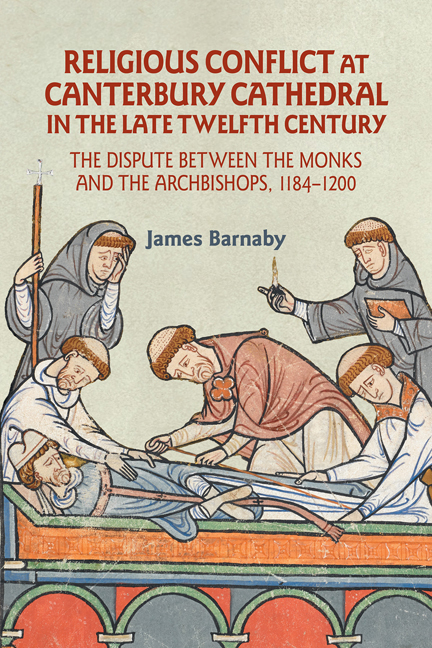 Religious Conflict at Canterbury Cathedral in the Late Twelfth Century
Religious Conflict at Canterbury Cathedral in the Late Twelfth Century Book contents
- Frontmatter
- Dedication
- Contents
- List of Maps
- Acknowledgements
- List of Abbreviations
- Introduction
- 1 The Canterbury Dispute in the Sources
- 2 Baldwin's Grand Plan (1184–November 1186)
- 3 To Rome (November 1186–July 1187)
- 4 The Hackington Dispute (August 1187–September 1189)
- 5 A New King, A Crusading Archbishop, and A Temporary Peace (September 1189–August 1191)
- 6 A New Primate (1191–3)
- 7 The Dispute Renewed (1193–1200)
- 8 After Lambeth: The Dispute in Later Centuries
- Conclusion
- Appendices
- Timeline
- Select Bibliography
- Index
- Other volumes in Studies in the History of Medieval Religion
8 - After Lambeth: The Dispute in Later Centuries
Published online by Cambridge University Press: 09 May 2024
- Frontmatter
- Dedication
- Contents
- List of Maps
- Acknowledgements
- List of Abbreviations
- Introduction
- 1 The Canterbury Dispute in the Sources
- 2 Baldwin's Grand Plan (1184–November 1186)
- 3 To Rome (November 1186–July 1187)
- 4 The Hackington Dispute (August 1187–September 1189)
- 5 A New King, A Crusading Archbishop, and A Temporary Peace (September 1189–August 1191)
- 6 A New Primate (1191–3)
- 7 The Dispute Renewed (1193–1200)
- 8 After Lambeth: The Dispute in Later Centuries
- Conclusion
- Appendices
- Timeline
- Select Bibliography
- Index
- Other volumes in Studies in the History of Medieval Religion
Summary
With the settlement of 1200 it appeared as though the dispute over a collegiate church was at an end. The last five years of Hubert's archiepiscopate were quiet. He never tried to build the house of Premonstratensians allowed under the agreement, nor did he try to revive the idea of a secular collegiate church. This suggests that Hubert never wanted to move the rights of the cathedral chapter to a new body. Both Sees and Whithorn had regular canons as the cathedral chapter. Whithorn in fact was a Premonstratensian chapter. If, as the monks insisted, the establishment of a new cathedral chapter was the plan, Hubert could easily have fulfilled this desire by building the permitted Premonstratensian house and transferring the episcopal see there.
Instead, Hubert repaired his relationship with the monks, who became very affectionate towards their archbishop. According to Gervase, there was so much affection that ‘by the grace of God it was as if they were of one heart and one soul’. Upon Hubert's death, Gervase even wrote a glowing encomium of the archbishop:
He was so bountiful, so liberal, and open-handed in entertaining guests and poor people, that what he possessed seemed to be the property of all. He was wonderful in erecting large and noble buildings. He was devout in the performance of divine service⦠But it was one great proof of his trust that he employed about him those whom he found faithful in service and truthful in words. Like Solomon he hated flattering lips, a lying tongue, and a forward mouth [Psalm 11.4, Proverbs 6.17, 8.13].
Although the settlement of 1200 was in the monks’ favour, the community was still unhappy with the result. While no new church was built, they had still lost revenues and estates, particularly the churches previously assigned to the almonry (Monkton, Meopham, Eynsford, and Eastry) and the exennia. In both cases the monks had a right to be dissatisfied with the settlement. The churches were to be held by the incumbents until their death, at which point they were to be divided equally between the monks and the archbishop. This division, however, did not take place, and during the thirteenth and fourteenth centuries the monks repeatedly tried to regain the churches.
- Type
- Chapter
- Information
- Religious Conflict at Canterbury Cathedral in the Late Twelfth CenturyThe Dispute between the Monks and the Archbishops, 1184-1200, pp. 177 - 200Publisher: Boydell & BrewerPrint publication year: 2024


